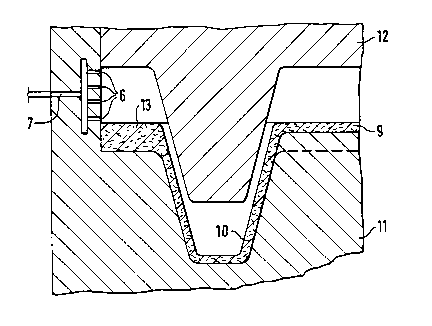Some of the information on this Web page has been provided by external sources. The Government of Canada is not responsible for the accuracy, reliability or currency of the information supplied by external sources. Users wishing to rely upon this information should consult directly with the source of the information. Content provided by external sources is not subject to official languages, privacy and accessibility requirements.
Any discrepancies in the text and image of the Claims and Abstract are due to differing posting times. Text of the Claims and Abstract are posted:
| (12) Patent: | (11) CA 2036584 |
|---|---|
| (54) English Title: | METHOD AND APPARATUS FOR MAKING A MOLDED ARTICLE FROM A NON-FLOWABLE MIXTURE OF CHIP AND/OR FIBER MATERIAL AND A THERMALLY HARDENABLE BINDER |
| (54) French Title: | METHODE ET APPAREIL DE MOULAGE D'ARTICLES A PARTIR D'UN MELANGE SOLIDE DE COPEAUX, DE FIBRES AGGLOMERES AU MOYEN D'UN LIANT THERMODURCISSABLE |
| Status: | Expired and beyond the Period of Reversal |
| (51) International Patent Classification (IPC): |
|
|---|---|
| (72) Inventors : |
|
| (73) Owners : |
|
| (71) Applicants : |
|
| (74) Agent: | SMART & BIGGAR LP |
| (74) Associate agent: | |
| (45) Issued: | 1995-02-07 |
| (22) Filed Date: | 1991-02-19 |
| (41) Open to Public Inspection: | 1991-08-21 |
| Examination requested: | 1991-10-24 |
| Availability of licence: | N/A |
| Dedicated to the Public: | N/A |
| (25) Language of filing: | English |
| Patent Cooperation Treaty (PCT): | No |
|---|
| (30) Application Priority Data: | ||||||
|---|---|---|---|---|---|---|
|
The process for making a molded article from a nonflowable
mixture of chip and/or fiber material and a thermally hardenable
binder, includes pressing the mixture in a press with a mold
closed on all its sides, hardening the mixture in the mold with
thermal energy, and feeding a hot gas, especially steam, in the
mixture during the pressing to supply at least a portion of the
thermal energy required for hardening. To heat and harden the
molded article in a minimum time, the hot gas is fed into the
mixture in a direction substantially perpendicular to the
pressing direction. A suitable apparatus for performing this
process is described in which the mold cavity has walls
containing feed ducts for the hot gas which feed the gas
perpendicular to the pressing direction.
Note: Claims are shown in the official language in which they were submitted.
Note: Descriptions are shown in the official language in which they were submitted.

2024-08-01:As part of the Next Generation Patents (NGP) transition, the Canadian Patents Database (CPD) now contains a more detailed Event History, which replicates the Event Log of our new back-office solution.
Please note that "Inactive:" events refers to events no longer in use in our new back-office solution.
For a clearer understanding of the status of the application/patent presented on this page, the site Disclaimer , as well as the definitions for Patent , Event History , Maintenance Fee and Payment History should be consulted.
| Description | Date |
|---|---|
| Time Limit for Reversal Expired | 2010-02-19 |
| Letter Sent | 2009-02-19 |
| Inactive: IPC from MCD | 2006-03-11 |
| Letter Sent | 2005-04-05 |
| Inactive: Office letter | 2005-03-08 |
| Grant by Issuance | 1995-02-07 |
| Request for Examination Requirements Determined Compliant | 1991-10-24 |
| All Requirements for Examination Determined Compliant | 1991-10-24 |
| Application Published (Open to Public Inspection) | 1991-08-21 |
There is no abandonment history.
| Fee Type | Anniversary Year | Due Date | Paid Date |
|---|---|---|---|
| MF (patent, 7th anniv.) - standard | 1998-02-19 | 1997-10-10 | |
| MF (patent, 8th anniv.) - standard | 1999-02-19 | 1998-12-11 | |
| MF (patent, 9th anniv.) - standard | 2000-02-21 | 2000-01-24 | |
| MF (patent, 10th anniv.) - standard | 2001-02-19 | 2000-11-21 | |
| MF (patent, 11th anniv.) - standard | 2002-02-19 | 2001-12-06 | |
| MF (patent, 12th anniv.) - standard | 2003-02-19 | 2003-01-08 | |
| MF (patent, 13th anniv.) - standard | 2004-02-19 | 2004-01-12 | |
| MF (patent, 14th anniv.) - standard | 2005-02-21 | 2005-01-07 | |
| MF (patent, 15th anniv.) - standard | 2006-02-20 | 2006-01-26 | |
| MF (patent, 16th anniv.) - standard | 2007-02-19 | 2007-02-05 | |
| MF (patent, 17th anniv.) - standard | 2008-02-19 | 2008-01-30 |
Note: Records showing the ownership history in alphabetical order.
| Current Owners on Record |
|---|
| WERZALIT AG AND CO. |
| Past Owners on Record |
|---|
| EDMUND MUNK |
| HELMUTH HUBER |